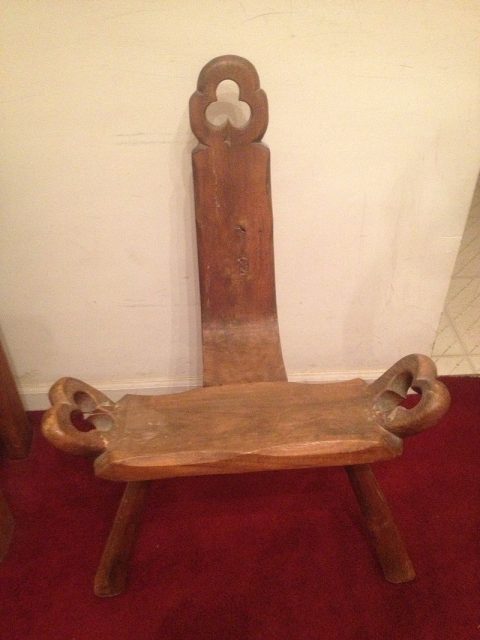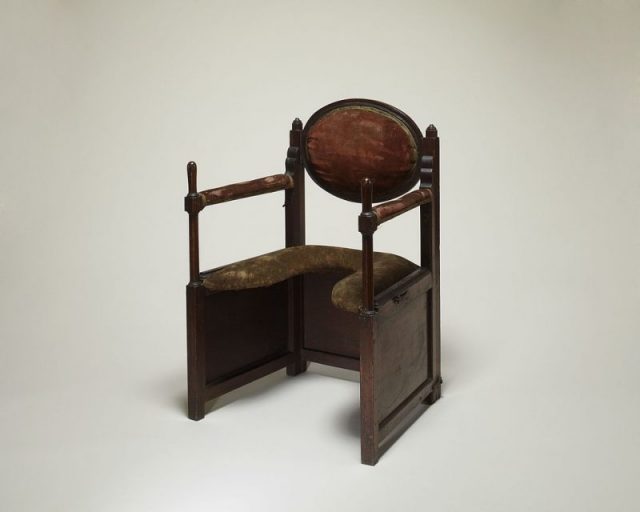When people think of Louis XIV, childbirth usually isn’t the first association. But after reading this that might change.
Most women in the modern world go through one of the most significant events in their lives laying down and on a hospital bed. However, history shows that childbirth was done very differently in some cultures in the past.
Rather than today’s exercised horizontal positions, 19,000 years ago in Ancient Egypt for instance, women adopted a squatting position to give birth. Centuries later, according to engravings from around 69 to 30 B.C. discovered in the Temple of Esneh in Upper Egypt, Cleopatra is shown giving birth to a baby kneeling in front of five women.
And in Ancient Greece, they used a birthing stool on which the mother would crouch and deliver the baby through a hole in it where one of the midwives was waiting below with open arms to catch the baby, while others were massaging the mother’s belly during labor.
The existence of birthing chairs can be traced back to the Babylonian culture 4,000 years ago and has been used ever since. In different cultures through different times, women almost always were found to give birth kneeling, squatting, or sitting. In some, they still are. Evidence tells us that pain during labor is the greatest agony one can go through. People tried everything they could to ease the process and found these to be the most “pleasant” ones for the mother perhaps.

Various studies, including a research paper from 2012 conducted by Janesh Gupta, Justus Hofmeyr, and Manjeet Shehmar for the Cochrane Database of Systematic Reviews, found the upright position, whether that be kneeling, sitting on a birthing stool, or squatting over chairs, to be the most convenient way to go. For the purpose of their review, “Position in the second stage of labor for women without epidural anesthesia,” they went through over 22 trials and studies involving 7,280 pregnant women in order to “assess the benefits and risks of the use of different positions during the second stage of labor.” The results were that when squatting and kneeling the pelvic outlet becomes wider along with the birth canal thus making the labor much shorter and the whole experience much comfortable.
Another study in the Cochrane Database clearly indicates that the first stage of labor for women walking or being upright is reduced by approximately an hour and a half, and the risk of cesarean birth and the need for an epidural was decreased as well. All in all, studies advise women to be encouraged to assume the position they see as the most comfortable for them or at least be informed of the benefits of the upright position.

CC BY 4.0
That being said, however, Western medicine advises women to give birth lying on their back and today the majority of them deliver babies horizontally, assuming the dorsal position where the mother is lying flat on her back, the lithotomy position, just the same or tilted slightly upwards with the legs lifted up in stirrups, or lying on her side in the lateral birth position. According to the same studies, by doing so, the caregiver is allowed more space for examination and potential interference if needed.
But it wasn’t until the beginning of the 18th century, when obstetricians and medical personnel who wished for an easier way to do their job and perform episiotomies (surgical cuts) and various other procedures to assist more carefully in delivery during risky pregnancies, that the horizontal position became the norm. And while it is still unclear who exactly started it, some believe that one king’s desire to observe his wives giving birth full frontal and up close could be one of the unusual reasons as to why it came to exist in the first place.

King Louis XIV was the Sun King as he preferred to be referred to, as he believed he was sent by God personally to rule France. Which he did, and for no less than 72 years.
His reign from the age of 4 in 1643 up until his death at the age of 76 in 1715 makes him the longest-serving monarch not only in the history of France but in all Europe. He built the extravagance named Versailles, owned the Hope Diamond, and inspired men to name a state across the Atlantic after him (Louisiana).
All in all, he was probably the most powerful man in Europe, if not the whole world, of his time. If not that, then the wealthiest without a doubt. Understandably, women adored him. Why wouldn’t they? He had everything to offer. Charm, grace, elegance, style, diamonds.
And he, well he loved them back. As the Sun loves the Moon. The king was known to have a healthy libido and supposedly shared his royal bed with a myriad of mistresses. So naturally, with a love so grand and passionate, and a life lived fooling around in times when any form of contraception or birth control was lacking, it was only logical that one of the girls he fooled around with would end up pregnant every once in a while.

That is probably an understatement. Aside from the six children with his first wife Marie-Thérèse, Louis fathered seven more with one of his mistresses, the Marquise de Montespan, four with another one, a whole bunch of others of which we know of and probably dozens more of which we don’t.
But what’s even more interesting, apart from being a dedicated womanizer and an expert in child-making, he was also determined to see all his loved ones give birth. According to some scholars and Lauren Dundes’ research paper for the American Journal of Public Health “The Evolution of Maternal Birthing Position,” King Louis XIV reportedly had a strange fixation and enjoyed watching women give birth but couldn’t under normal circumstance for a chair (birthing stool) obscured his view. Clearly frustrated, in a pursuit of greater happiness and ultimate satisfaction, he promoted a new method. Lying down, legs up and spread as wings of an eagle so he could closely inspect what was going on in detail.

Apparently, he enjoyed it so much to the extent that a special bed was designed to suit his demands, and in time the practice grew in popularity.
According to the journal, giving birth lying down was standard practice in the last two centuries and “recorded history of birthing indicates upright birth postures were used extensively” before that. So though a strong connection cannot be made between a king and his obsessions on one hand, and modern medical procedures on the other, it seems that the influential leader perhaps had a say of what would be the preferred method of doing things at a time he reigned.
For what it is worth, King Louis XIV was close friends with Frere Jacques, a famous French lithotomist and as the journal concludes, “the adoption of the lithotomy position for birthing and extensive practice of the lithotomy operation occurred at the same time and place in France in the 17th century.” And as to why it is still a preferred method today, a substantial prevention of blood loss during labor could play a part.
